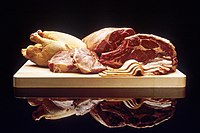
Photo from wikipedia
Abstract This study compared the meat and eating quality from fattening pigs raised in a free-range system involving two cross-breeds: Duroc x (Landrace x Yorkshire) (DYL); and Tamworth x (Landrace… Click to show full abstract
Abstract This study compared the meat and eating quality from fattening pigs raised in a free-range system involving two cross-breeds: Duroc x (Landrace x Yorkshire) (DYL); and Tamworth x (Landrace x Yorkshire) (TYL) and two feeding strategies (semi-ad libitum (NORM) or restrictive feeding of concentrate (80-50% of semi-ad libitum; RES)). Sixteen female pigs from each cross-breed were strip-grazing diverse pasture with a grass-clover mixture and forage herbs (338 m2/pig) and root chicory (34 m2/pig) from the age of 88 days and an average live weight of 32.2 kg (SD=1.9), and were allocated to either the NORM or RES feeding strategy after a three-week training and adaptation period. The NORM pigs were slaughtered after 68 days and RES pigs were slaughtered after 90 days of experimental feeding, in order to allow them to obtain the same slaughter weight as NORM within each cross-breed. Meat and eating quality was determined on the M. longissimus lumborum (LL) and the M. biceps femoris (BF) removed twenty-two hours post mortem. The DYL were superior to the TYL crossbreed when it came to carcass weight (84.6 vs. 70.3 kg) and lean percentage (63.6 vs. 54.5%) no matter the feeding strategy. The RES feeding strategy caused smaller carcasses (8.7%) with higher lean percentage (+1.5%). The BF was tenderer from the DYL crossbreed, whereas the LL from the TYL crossbreed had less acid and metal but sweeter flavor. The restricted feeding strategy had a negative impact on the texture of specifically the loin both measured as Warner Bratzler shear force (+8 N, 4 days post mortem) and as tenderness evaluated by a sensory panel, whereas the flavor of the meat was unaffected. The restricted feeding caused a change towards more poly-unsaturated fatty acids and n3 fatty acids and a lower ratio of n6/n3 fatty acids in the meat, which is favorable from a human nutrition point of view.
Journal Title: Livestock Science
Year Published: 2021
Link to full text (if available)
Share on Social Media: Sign Up to like & get
recommendations!